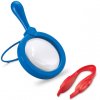I want to buy a loupe for looking at my bevel. I don't mind spending a bit of money provided what I get is worth it. Unfortunately, I don't have access to the brands many of you have, so I have to evaluate them myself.
1. I understand clarity is the most important. I assume, all things being equal, that glass would be better than plastic, but I may be wrong here. Has plastic improved to the point that the difference is negligible?
2. How do I test clarity in the store? Will it be obvious, or are there little tricks that can be used to help distinguish which one is actually better?
3. I read that some loupes aren't really the the stated magnification (ie. it says 40x, but really it's much less). Do I just sample a bunch side by side looking at the same object to see which one looks bigger?
Basically, I'm looking for whatever steps or tips would be helpful when evaluating which one to buy. Conversely, what are some indicators of a poor quality loupe?
Thanks.
1. I understand clarity is the most important. I assume, all things being equal, that glass would be better than plastic, but I may be wrong here. Has plastic improved to the point that the difference is negligible?
2. How do I test clarity in the store? Will it be obvious, or are there little tricks that can be used to help distinguish which one is actually better?
3. I read that some loupes aren't really the the stated magnification (ie. it says 40x, but really it's much less). Do I just sample a bunch side by side looking at the same object to see which one looks bigger?
Basically, I'm looking for whatever steps or tips would be helpful when evaluating which one to buy. Conversely, what are some indicators of a poor quality loupe?
Thanks.
Last edited:



